| Home > Policy > White Paper, Notice, Announcement > White Paper > Japanese Government Policies in Education, Science, Sports and Culture 2000 > Part 1 Chapter 1 Section 1 5 | ||
Although there has recently been little growth in the number of foreign travelers visiting Japan due to issues such as the effect of the recent Asian currency crisis, it is rising in the mid- to long-term-4.44 million visitors were recorded in 1999, the highest ever. Also, the number of Japanese traveling overseas has increased dramatically, reaching 16.36 million in 1999 (See Figure 1-1-23 ).
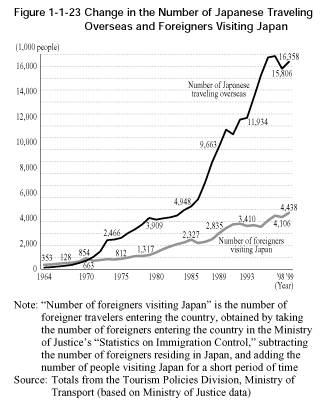
Although this trend is thought to reflect the increase of interest in the cultures of different countries, the number of foreign travelers visiting Japan is much smaller than the number of Japanese nationals journeying abroad. This situation leaves room for improvement.
To further increase the number of foreign travelers to Japan, efforts are being made to promote tourism based on the "Welcome Plan 21" (an initiative designed to double the number of overseas visitors to Japan) and the Law for the Promotion of International Tourism Through the Diversification of Areas Visited by Foreign Tourists (promulgated in June 1997) which aims to double the number of foreign travelers to Japan (to 7 million) by 2005.
According to the Prime Minister's Office's "Public Opinion Poll on Diplomacy" (October 1999), 80.3% of respondents answered that the internationalization of Japan was "desirable" or "somewhat desirable," with 33.0% raising "the enrichment of Japanese culture" as the reason (See Table 1-1-7 , Figure 1-1-24 ).
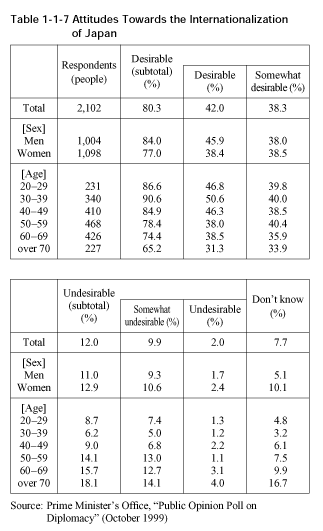
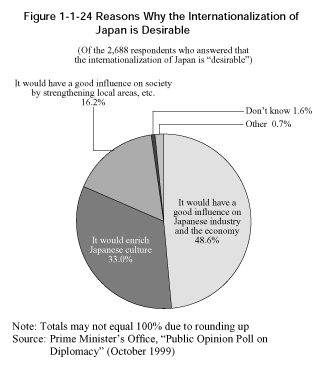
Globalization, resulting from the rapid spread of the Internet, has increased the status of English in the international community. It has been pointed out that, while cultures are becoming homogenized by globalization, a dynamic coexistence between different cultures is indispensable as a basis on which each culture can develop.
As part of this trend, the ASEAN Multinational Cultural Mission, comprised of the Japanese Government, governments of the Association of Southeast Asian Nations (ASEAN), and 20 representatives from the private sector, was formed in 1997, making regular visits to participating countries and holding active discussions. Based on these discussions, the Multinational Cultural Mission recommended in 1998 that, "In the midst of the rapid progress of globalization, Japan and ASEAN share an awareness of the danger of losing tangible and intangible cultural heritage. In order for the sustainable development of a culture rich in creativity, it is important to further mutual understanding among people of different nationalities and to cultivate common values while at the same time maintaining respect for cultural diversity." Their recommendation encourages an appreciation for culture in today's rapidly globalizing society.
In addition, the G8 Communique Okinawa 2000 at the Kyushu-Okinawa Summit in July 2000 stated that cultural diversity "is a source of social and economic dynamism which has the potential to enrich human life in the 21st century, as it inspires creativity and stimulates innovation." This perception is considered a foundation for future international cultural exchange.
With the progress of globalization, cultural activities have become more internationalized. At the same time, in order to promote culture that can stand up to domestic and international evaluation, international exchange is becoming increasingly important.
Performing arts performances in Japan and abroad and exhibitions of foreign artworks held in Japan enjoy a great deal of popularity.
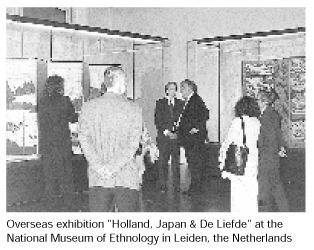
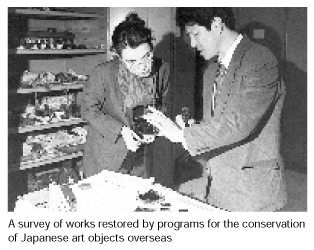
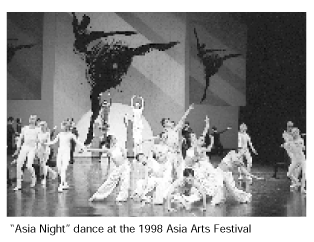
In order to introduce Japan's exceptional art objects to the rest of the world, and to deepen the understanding of people overseas towards Japanese history and culture, the country sponsors have held exhibits of classical Japanese art in Europe and Asia. Public and private art museums also conduct several overseas exhibits every year in conjunction with art museums in other countries. These exhibits fascinate many visitors.
At the same time, although art museums in the United States and Europe maintain classical Japanese works of art, these art objects are often made of fragile materials and therefore special techniques are necessary to restore them. As some of the museums concerned do not have staff skilled in the necessary techniques, those art objects are in critical condition. Based on these circumstances, cooperative efforts are being made to restore classical Japanese works of art stored at foreign museums and art museums.
Next, in the field of performing arts, it is necessary to further international art activities through overseas performances such as participating in overseas festivals, sponsoring international festivals, and coordinating joint international productions with foreign artists and arts organizations. The New National Theatre in Tokyo was opened in 1997, increasing opportunities to enjoy opera and ballet performed by foreign companies. It is expected that recent activities such as Japanese art organizations inviting modern performing arts groups from Asia for joint performances will create new possibilities to form links with different cultures of other Asian countries.
In addition, Japanese films have begun to receive high acclaim at international film festivals. For example, director Shinji Aoyama's film "Eureka" won the International Critics' Federation Award at the Cannes Film Festival.
According to a survey by the Japan Foundation, the number of people overseas studying the Japanese language is on the rise, from 980,000 in 1990 to 2,100,000 in 1998. At the same time, although the number of full-time teachers is also increasing, in light of the rapid increase in the number of students of Japanese, there has continued to be a shortage of instructors (See Figure 1-1-25 and Table 1-1-8 ). Japan has been implementing projects such as the Regional and Educational Exchanges for Mutual Understanding (REX) program, in which local public organizations dispatch experts in Japanese instruction to public lower and upper secondary schools through cooperation with the Ministry of Education, Science, Sports and Culture and the Ministry of Home Affairs, the Dispatch of Experts of Japanese Teaching through the Japan Foundation, and the dispatch of Japan Overseas Cooperation Volunteers (Japanese teachers) through the Japan International Cooperation Agency (JICA) (See Table 1-1-9 and 1-1-10 ).
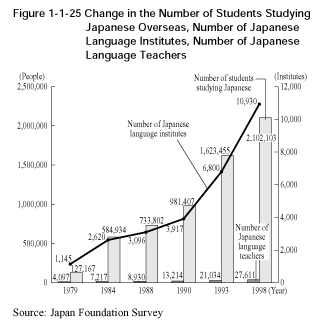
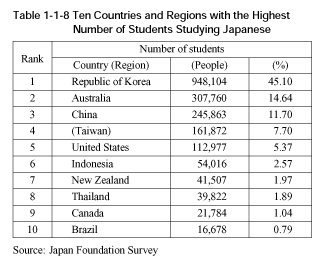
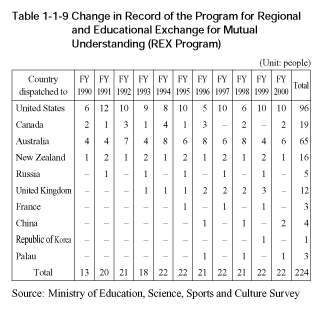
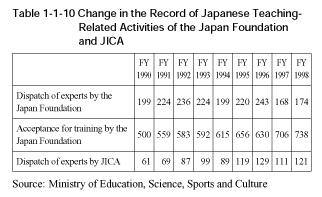
A program has also been established to accept college students majoring in Japanese language or Japanese culture at overseas universities as Japanese government scholarship students for one year (See Figure 1-1-26 ).
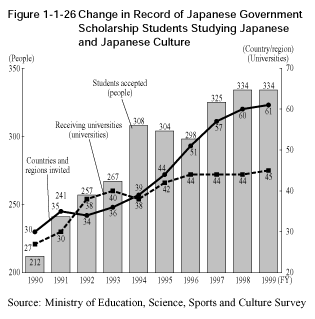
Also, according to a survey by the Japan Foundation, overseas Japanese language institutes have pointed out the lack of Japanese teaching materials, the inadequacy of facilities and equipment, insufficient information about Japanese materials and teaching methods, and a shortage of information about Japanese culture.
According to the "Public Opinion Survey Regarding the Japanese Language" (FY1999) conducted by the Agency for Cultural Affairs, regarding the increase in the number of students studying Japanese abroad, approximately 80% of Japanese people responded that it would be good if the number of people studying Japanese throughout the world increased further. Many respondents also expected that "Exchange between Japanese and foreigners will flourish," "Japanese culture will be better understood by people of the world," "Japanese will be used more for communication throughout the world," and "People's familiarity with Japan and Japanese people will increase" (See Figure 1-1-27 ).
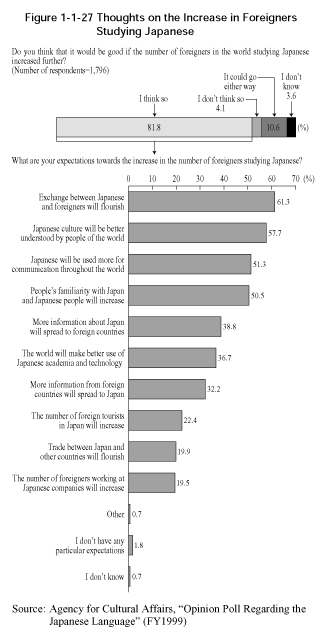
At the same time, the number of foreigners living in Japan (the number of registered aliens) has increased to 1.56 million (as of the end of 1999), a dramatic increase compared to the 980,000 ten years ago in 1989 (according to a Ministry of Justice survey) (See Table 1-1-11 ). Reflecting this situation is the fact that the number of students of Japanese, the number of Japanese language institutes and facilities, and the number of Japanese language instructors have been increasing over the past ten years (See Figure 1-1-28 ).
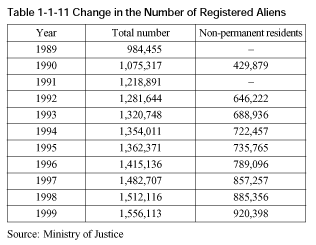
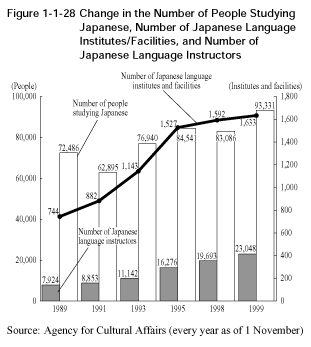
This situation is also reflected in the Japanese Language Proficiency Test, which measures and recognizes Japanese language ability of people for whom Japanese is not their native language. This exam has been conducted since 1983 in Japan and since 1984 abroad. The number of people taking the exam both in Japan and abroad is steadily increasing; in FY1999, the exam was taken by 34,334 people in Japan and 132,241 people abroad (in 33 countries and regions (75 cities)) (See Figure 1-1-29 ).
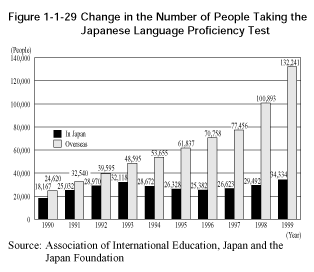
In order to respond to the increase in the number of students of Japanese and the demand for learning both in Japan and abroad, as well as the diversity of study objectives, the promotion of the study of Japanese as a language for communication and the active spread of Japanese as a foundation for the transmission of Japanese culture will become issues.
Japan became a state party to the World Heritage Convention in 1992, and the 22nd session of the World Heritage Committee was held in Kyoto in 1998.
Since Japan ratified the Convention, the Japanese Government has expressed to the international community that the value and conservation methodology of cultural properties are apt to show strong bias towards the "stone culture" viewpoint developed in European countries, and those in "wood culture" cannot be considered on the same basis as those in "stone culture." For inscription on the World Heritage List, it is required that each cultural property meet the test of authenticity in design, material, workmanship, and setting. Compared with buildings made of stone or brick which have considerable durability against wind and rain, wooden buildings, a part of "wood culture," need periodic replacement of materials or dismantling/restoration of significant structures in order to secure their durability. In this kind of conservation practice, some experts and scholars in Western countries have not expressed favorable opinions about the authenticity of wooden buildings.
In order to discuss this issue, in 1994 the Agency for Cultural Affairs invited experts from various culture areas throughout the world to the Nara Conference on Authenticity in Relation to the World Heritage Convention held in Nara. As a result of this international expert meeting, the diversity of cultures in the world was recognized, and it was agreed that the value and authenticity attributed to heritage should be made from a more comprehensive point of view, including the material aspect and the cultural context of each property. The declaration entitled "The Nara Document on Authenticity" today plays an important role in evaluating World Heritage. It can be said that Japan's action not only broadened the recognition of "wood culture," but was also meaningful in taking a multi-dimensional view of values attributed to various cultures of the world.
Cooperation through UNESCO also includes dispatching experts, providing materials, and building facilities in order to protect tangible cultural heritage, in response to requests from developing countries, as well as preserving intangible cultural heritage such as traditional performing arts, traditional crafts, and oral literature.
Recently, many Asian countries have begun to actively work towards the protection of their own cultural properties. However, it has been pointed out that actually, in many countries, not a few cultural properties are facing many dangers, including destruction, damage, and hasty, careless repair and reconstruction for tourism due to the scarcity of human resources to formulate plans for the entire area of administration for the protection of cultural properties and to preserve and repair individual cultural properties, as well as inadequate laws and a lack of necessary resources.
It is recognized by the international community that Japan has attained a high level of research, conservation, and restoration techniques for cultural properties protection, and many Asian countries expect further cooperation from Japan in this field.
With the recent rapid advancements in information technology (IT) and the development of electronic commerce such as online music distribution, it has become easy for intangible works of art to be exchanged internationally through the Internet. Consequently, artistic works have come to be protected internationally through treaty frameworks.
The most basic frameworks for the protection of international copyrights are the Berne Convention for the Protection of Literary and Artistic Works (1886), which deals with copyrights, and the International Convention for the Protection of Performers, Producers of Phonograms and Broadcasting Organisations (the Rome Convention) (1961), which deals with neighboring rights. In addition, the TRIPS Agreement (Agreement on Trade-Related Aspects of Intellectual Property Rights), which targets intellectual property rights in general, was formulated in 1995 as one of the Annexes of the Marrakesh Agreement Establishing the World Trade Organization (WTO).
Furthermore, at the World Intellectual Property Organization (WIPO) Diplomatic Conference in 1996, the new WIPO Copyright Treaty and the WIPO Performances and Phonograms Treaty were newly adopted as international copyright protection rules to respond to the recent rapid trend towards digitalization and the spread of networks. In 1997 and 1999, Japan made necessary revisions to its Copyright Law in accordance with the two treaties, and concluded the WIPO Copyright Treaty in June 2000. It is also considering joining the WIPO Performances and Phonograms Treaty.
| Back to Top | MEXT HOME |